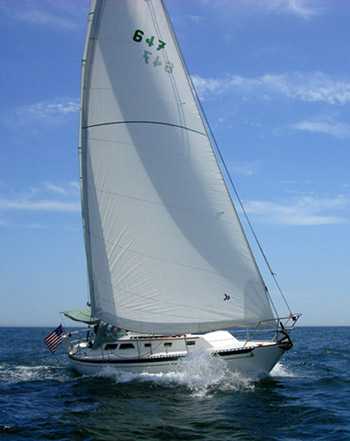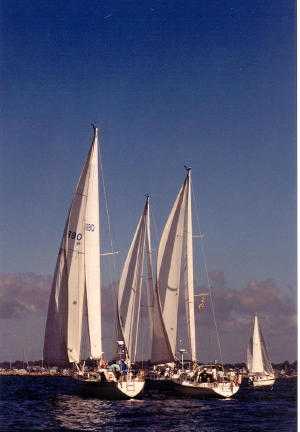Islander 36

The Islander 36 sloop is an inboard-powered, family cruiser and weekend racer with berths for six.
The I-36, as she is commonly referred to, is a mid-volume production, California-built, fiberglass-reinforced vessel with an early 1970s to 1984 manufacturing run of about 650 vessels. Many of these boats are still being sailed.
There is an active, California based, Islander 36 Association that offers support and technical assistance, and holds several summer regattas and cruises for this vessel. The Islander 36 Association also has many non-resident members from across the country.
Islander 36

Islander Yachts ceased operations in the mid-1980s. During its existence, Islander produced many sizes of sailboats ranging from 21-foot (6.4 m) to 40-foot (12 m). The most popular and longest selling boat Islander produced was their 36-foot (11 m) long sloop, commonly called the I-36. This boat is of fiberglass construction with a wood-cored fiberglass deck and cabin roof. It has a skeg-mounted rudder and a fin keel.
The hull and rig were designed by naval architect Alan Gurney. The deck, cockpit and interior were designed by Joseph Artese Design.
During the last few years of production the I-36 interiors were largely finished in teak, with a teak and holly cabin sole (floor). Earlier models also used the teak and holly floor, with a mix of white fiberglass and teak accents on the bulkheads (walls) in the living areas. Ventilation below deck is provided by two overhead hatches and six opening cabin ports. There are also four, larger, non-opening side windows.
This boat follows the general layout for most single-mast sailing yachts, having a mainsail and a foresail, with the cockpit at the back of the boat. All Islanders of this length are inboard powered.
Engine types
The Islander 36 has had many engine types installed during its years of production. The early boats had gas engines, but later models offered diesel engines at an extra cost over the gas models. After the Atomic 4, and Palmer P-60 gas engine era, the mid-1970 diesel models used the Perkins 4-108 diesel engine. Later in the 1970s the Westerbek L-25 four-cylinder diesel was offered. In 1980s all Islander 36s were diesel powered. Early 1980s used a Pathfinder 42 hp (31 kW) diesel engine, and the last-generation models utilized the Yanmar model 3hmf 30 hp (22 kW) motor.
Layout
Foredeck
The foredeck is typical, containing an anchor roller and locker, two mooring cleats, and the forestay. The area under the roller and cleats is trimmed out in teak. The front overhead hatch is on an elevated section over the V-berth portion of the cabin. There is a clear space between the anchor locker and the cabin allowing for maneuverability on deck.
Cockpit
The cockpit is reasonably deep, with small- to medium-sized drains. Most I-36s have a wheel for steering, and an emergency tiller attachment. An engine monitor panel is to the right of the wheel, about knee height. To port and starboard are cockpit coaming boxes. A locker with engine access is in the starboard bench, and two lazarettes on the aft bench, with the tiller attachment placed between them.
Cabin
From the companionway the galley is immediately to starboard, while a chart table over a drawer stack is to port. A wall separates the aft end of the galley from the cockpit sail locker.[1] The galley is separated on its forward side from the main cabin by a low wall. Aft of the chart table is a quarter berth. Forward of the chart table and galley are two settees; the port settee is able to unfold into a double sleeping berth.[1]
Forward is a hanging locker to the starboard side and a head to the port side. The mast passes through the cabin roof at the aft-most point of the head. At the most forward section of the main cabin is door to the v-berth, master stateroom. This sleeping area contains a second hanging locker, plus an anchor locker door at the narrow end of the v-berth. The head has a door, sink with storage underneath, shower, and toilet. The galley has a sink, refrigerator or icebox, and a combined stove/oven.
Mid-deck
The mast rises from the deck 14.5 feet (4.4 m) aft of the bow. Four shrouds are on each side of the mast, two lower shrouds for fore and aft adjustment of mast prebend, plus the upper and intermediate shrouds to keep the mast straight. There are two pairs of spreaders. The standard mast is 45 feet (14 m) tall off the deck, however a taller mast option was also offered. There is a perforated toe rail running along the deck and hull joint, and a genoa car track set well inboard. Teak handrails and cabin side teak eyebrow trim pieces are mounted on the raised cabin roof.
Sailing tendencies

These boats have a relatively small mainsail compared to other yachts of their size. They use a large headsail to increase sail area. The boom is relatively high from the bottom of the cockpit, and the end is more forward. Mainsail controls are achieved through a cabin-top mounted winch, leading to a traveler car system running across the deck in front of the main cabin's sliding hatch.
Modern organizations
The Islander 36 Association has information on races for these and other yachts, as well as tips for maintenance and other useful information.
External links
- Islander 36 Association
- Latitude 38 Magazine
- Soundings Magazine
- U S Sailing association
- Islander 37 Association
- Talk of the Dock review